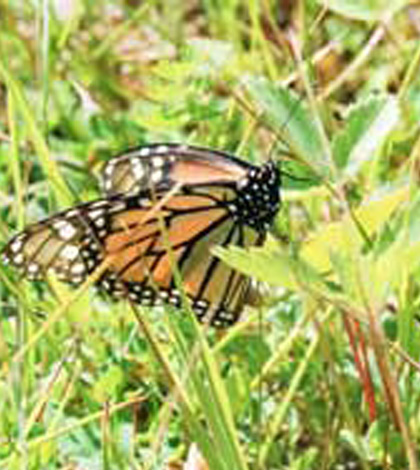LITTLE CURRENT—The role of the citizen scientist can bring moments of spellbinding wonder while playing an important role in the advancement of human knowledge.
“Standing on the shores of Providence Bay, watching a monarch butterfly flutter ashore after crossing the breadth of Lake Huron, frantically looking along the shoreline for sustenance to provide fuel for it to continue on its journey, is a wonderful experience,” said Dr. Joe Shorthouse.
An especially wondrous moment considering that the annual migration flight of the monarch butterfly takes it from Canada’s North thousands of miles south to the balmy winters of Mexico each year, an epic journey that has captured the hearts and minds of people living all along its flightpath, becoming an iconic symbol of nature and the environment. Sadly, the monarch butterfly has become a symbol of nature imperiled, as its numbers have stubbornly refused to rebound from disastrous declines over the past couple of years.
It had been hoped that the steep decline in the monarch butterfly population would come up with better weather this past spring, but so far, the numbers being reported on the annual migration are not encouraging.
Recent surveys of roosts in Point Pelee and other migration jump-off points indicate the monarch populations are continuing to decline—down to 17 roosts in Point Pelee this year from 25 last year and 55 in 2011. Poor dry springs and declining milkweed pods across the continent mean that numbers of the fluttering travellers with their distinctive orange wings reaching Mexico have dropped to 60 million from a normal cloud of 350 million.
After 30 years of studying the migrations of eastern monarchs, zoologist Fred Urquhart finally confirmed the site where the butterflies migrate to in 1975. Dr. Urquhart discovered that they winter in the forests of pine and oyamel fir in central Mexico, along the border of the states of Michoacán and Mexico—a voyage of over 4,000 kilometres. This migration is unique in the world, as millions (maybe as many as a billion) of monarch butterflies travel from a relatively small geographic area in Mexico to disperse across the vast expanse of North America, anywhere that the ubiquitous milkweed plant is to be found. The butterflies spend about five months in Mexico, arriving around October and leaving again for their summer (including Manitoulin) homes in March.
Retired Laurentian University professor Dr. Joe Shorthouse, whose popular Bugfest summer camps at Batman’s Camp and Trailer Park are the stuff of local legend and who is a regular contributor to the pages of The Expositor, took a few moments out to discuss the plight of the monarch butterfly and the important role citizen scientists can play in helping discover the cause, and perhaps the solution, to turning around the decline in monarch butterfly populations.
“Citizens can make an important contribution to discovering what is happening in the environment,” said Dr. Shorthouse. “School teachers are doing a great job in educating their students about the issue and doing a great service to the cause of environmental issues.”
He noted that humanity’s perspective on the forest, especially here in North America, has changed significantly since the arrival of the first settlers to the region. “At one time we looked at the forest and only saw the value of the cut timber and the agricultural potential of the land upon which it stood,” said Dr. Shorthouse. “Now we are coming to realize that the important role that forests play and that a forest can have intrinsic value of its own standing undisturbed for generations.”
The monarch butterfly, and its plight along with other pollinators whose numbers are currently in steep decline, is acting in the preverbal role of a canary in the coal mine on many environmental issues, particularly the indiscriminate use and overuse of pesticides along the flightpath of the insects. While bees and monarchs are currently in the crosshairs of the media and public attention, there are a host of wasps, beetles, flies and other insects who play a critical pollination role in nature and agriculture that are also facing precipitous declines.
Sadly, much of the corporate funding that is leveraged by government and academic programs to conduct research is focussed on short term commercial applications and biased towards promoting the agendas of corporate bottom lines.
The importance of research for the sake of curiosity is what really drives new discoveries and propels knowledge forward, opening lines of hitherto undiscovered breakthroughs in human understanding of the world we live in. The gap between corporate and commercial interests and the love of discovery for the love of pure science has left a significant gap in allocated resources, a gap that provides a significant role for the citizen scientist to help fill.
Utilizing computers and the Internet, citizen scientists made up of ordinary people with a love of knowledge and discovery and a computer (“Who doesn’t have a computer these days,” said Dr. Shorthouse) can help track sightings and plot data that can add significantly to the information we have on species such as the monarch.
“Using a website like Journey North (www.learner.org/jnorth/
monarch) you can plot the sightings online and see on the map where your sightings are relative to the others on the monarch flightpath,” he said.
Even the media can play a role. “After an article on the monarch appeared in The Expositor where I asked people to call me if they had a sighting I received about a dozen calls from people excited to tell me about their sighting,” he said.
Little Current Public School early childhood educator Janet McCarville agreed that teaching students about creatures like the monarch is important. “In fact, it is absolutely essential,” she said.
Ms. McCarville’s Kindergarten charges raised, tagged and released a couple of monarch butterflies this summer and early fall, and noted that they had not yet heard anything about their particular insects. “It is pretty rare to actually hear back about your individual butterfly,” she said. “But we have our virtual migration that we will hear back from in the spring.”
In the virtual migration students cut out and colour paper butterflies and mail them out. The cutouts are sorted and sent to corresponding schools in Mexico, where students create their own butterflies for the return journey.
“We will be getting ours back in the spring,” she said.
The young scientists at LCPS have another project in the works to help reverse the population declines. “We have frozen a number of different species of milkweed pods,” said Ms. McCarville. “In the spring we are hoping to create a butterfly garden.”
If they can attract a few butterflies, it can make a big difference. Each monarch can lay up to 100 eggs.
In the meantime, entomologists both professional and citizen will be scanning the southern skies come this spring. “I hope and pray that the monarchs will return next June,” said Dr. Shorthouse. “Planting their eggs and increasing their populations to as large a number as possible.”





